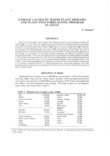Rice is one of the major crops in Japan. Rice diseases of main concern in Japan are blast and sheath blight. 1. As for blast, the outbreak area ratio (outbreak area/planted area) has decreased, since 1985 for leaf blast, and since 1983 for panicle blast. The ratio of chemical treatment area for leaf blast increased gradually from 1955 to 1980 and has remained stable since 1981, while for panicle blast it increased gradually from 1955 to 1980 and has decreased since 1981. The ratio of damaged quantity to normal production has decreased since 1981. The main contributing factors to this change are considered to be favorable weather conditions and effective control by newly introduced pesticides. 2. The ratio of outbreak area for sheath blight increased gradually from 1955 to 1971 and has remained stable since 1972. The ratio of damaged quantity to normal production is around 1% each year. The cause of the outbreak change depends on the planting density. The stability of the ratio of damaged quantity, despite the increase of the ratio of outbreak, is attributed to the spread of chemical control. 3. Computer-assisted pest forecasting programs have been developed and are being used for predicting the initial occurrence of blast and the ratio of affected hills by sheath blight.

